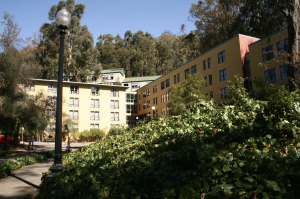By Alice Shao
T
he BART station in Downtown Berkeley was closed, and remains partially shut down, in order to undergo renovations. Despite its recent reopening, many questions persist around the changes. For instance, the southwest entrance on Shattuck and Kittredge has a renovated shell-entrance with no roof. Additionally, the interior of the station remains almost unchanged despite the removal of the rotunda. The motivation to renovate has led to some of the seemingly unnecessary changes to the station. “We wanted to redo the main entrance so that we could increase access into and out of the stations,” stated Rebecca Saltzman, BART Director for district three, which includes Berkeley. “Originally, the entrance only had two escalators —one going up and one going down — with a gap in between the two. We renovated the entrance so that there is also a set of stairs in between the escalators which means more people can go in and out of the station, which will help manage the flow of people using the station during rush hour.”
Rebecca Saltzman has been a long-time policy advocate and a voice for public transportation. She was elected onto the BART Board to represent district three six years ago. “I ran for BART Board because I didn’t like the policy decisions being made by the board at the time. It was too focused on expanding [the BART system] even though it wasn’t improving its existing infrastructure. Now we’ve really been able to focus on improving the current infrastructure.” As Director, Saltzman works closely with many other local government entities when making large decisions. “We worked very closely with the City of Berkeley when it came to the renovations. They really wanted a space that would help community building which is why we have the plaza today.”
Although Saltzman is a director for district three, she is also heavily involved with decisions pertaining to the entire BART system. As rumours and possibilities of another transbay tube has been discussed, Saltzman and the BART Board must also consider the impacts renovations, extensions, and improvements have on the local community. For instance, when the BART was first built in West Oakland almost sixty years ago, neither the city nor the BART organization considered the impact of noise pollution on the surrounding area. As a result, a vibrant jazz culture in the area died due to the introduction of BART. When asked about what steps BART is taking to mitigate their negative impacts in certain communities, Saltzman responded with innovative solutions the organization is currently reviewing. “We’re definitely more aware of BART’s impact in local communities now than we were before. We recognize that issues such as noise pollution heavily impacts peoples’ lives. We just had a presentation this past week showcasing a newly designed train wheel which would decrease the amount of noise BART makes as it travels on the rails.”
It is important to note that the future of BART also impacts the future of other policy issues, including the ever-growing Bay Area housing crisis. While a large benefit of increased public transportation allows for more people to work in San Francisco, it is unknown whether the increased job opportunities in the Bay Area have also led to the skyrocketing of housing prices. “All policies are closely related. BART is trying to find ways to more efficiently utilize the land it has for its parking lots. We’re thinking of building affordable housing units on top of some of them. At the Lake Merritt Station, we are working with the City of Oakland to build office spaces for non-profits since the high residential prices were driving out these organizations. Each community is different and wants different things so we need to adjust to them.” Irrespective of its postponements in opening the newly renovated stations and introducing the new cars, it is undeniable that the organization is aiming to create a more accessible and inclusive community in the Bay Area. When asked about why there was entry roof on the Shattuck and Kittredge station, Saltzman chuckled before saying, “The city [of Berkeley] wanted to increase the funding in the pavement outside of the station so we had to cut somewhere else which ended up being the roof of that entrance.” Perhaps what they need in order to achieve their ambitions and improve the heavily-used BART infrastructure throughout the Bay is augmented funding.








Be First to Comment